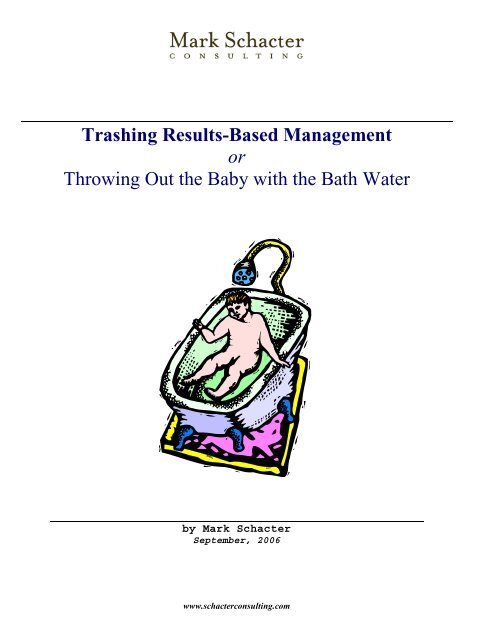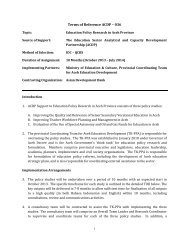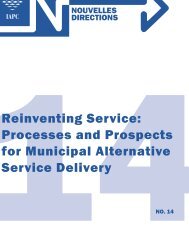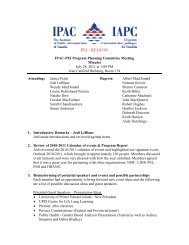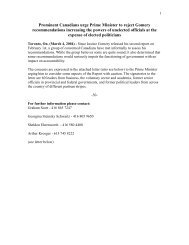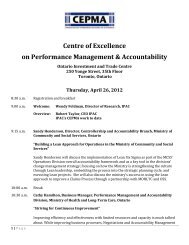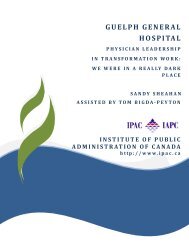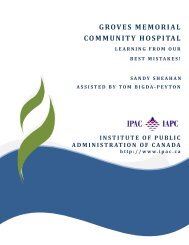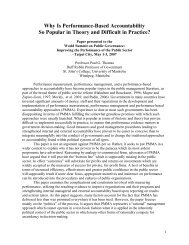In Defence of Results-Based Management by Mark Schacter
In Defence of Results-Based Management by Mark Schacter
In Defence of Results-Based Management by Mark Schacter
You also want an ePaper? Increase the reach of your titles
YUMPU automatically turns print PDFs into web optimized ePapers that Google loves.
Trashing <strong>Results</strong>-<strong>Based</strong> <strong>Management</strong><br />
or<br />
Throwing Out the Ba<strong>by</strong> with the Bath Water<br />
<strong>by</strong> <strong>Mark</strong> <strong>Schacter</strong><br />
September, 2006<br />
www.schacterconsulting.com
© September 2006<br />
All rights reserved<br />
Trashing <strong>Results</strong>-<strong>Based</strong> <strong>Management</strong>; or, Throwing Out the Ba<strong>by</strong> with the Bath<br />
Water<br />
Published <strong>by</strong>:<br />
<strong>Mark</strong> <strong>Schacter</strong> Consulting<br />
5 Linden Terrace<br />
Ottawa, Ontario Canada<br />
K1S 1Z1<br />
www.schacterconsulting.com<br />
mark@schacterconsulting.com<br />
www.schacterconsulting.com
Table <strong>of</strong> Contents<br />
1 “Surreal and unhelpful” ..................................................................... 1<br />
2 The Criticism Rings True . . . ............................................................. 2<br />
3 . . . But it is Only Part <strong>of</strong> the Story .................................................... 3<br />
4 Don’t Throw Out the Ba<strong>by</strong> . . . ........................................................... 4<br />
5 Understand What Not to Do............................................................... 5<br />
(i) When told to develop performance measures for a program, do not immediately<br />
proceed to develop performance measures. ..................................................................6<br />
(ii) Do not sow confusion with sloppy language..........................................................7<br />
(iii) Don’t use the wrong tool to assess performance. ..................................................8<br />
(iv) Don’t take the credit (blame) for saving (not saving) the world. ...........................9<br />
(v) Don’t mistake a leadership problem for an RBM problem. ....................................9<br />
(vi) Don’t mistake a Treasury Board problem for an RBM problem..........................10<br />
6 Conclusion ..........................................................................................10<br />
www.schacterconsulting.com
Trashing <strong>Results</strong>-based <strong>Management</strong>; or, Throwing Out the Ba<strong>by</strong> with<br />
the Bath Water<br />
1 “Surreal and unhelpful”<br />
Much has been said and written over the past decade advising on, and promoting, the<br />
implementation <strong>of</strong> results-based management (RBM) in the public service. Experts and<br />
practitioners from inside and outside government (including me, in the latter category)<br />
have spoken at workshops and conferences, led training sessions, advised organizations<br />
and produced articles – all citing the virtues <strong>of</strong> RBM and providing advice on how to<br />
make it work.<br />
It’s fair to say that an aura <strong>of</strong> “political correctness” surrounds RBM in the public service,<br />
and it’s easy to understand why. At the level <strong>of</strong> principles, who could oppose it? What<br />
reasonable person would argue against managing public programs and measuring their<br />
performance in relation to social and economic results that will improve the lives <strong>of</strong><br />
Canadians?<br />
And yet, propositions as compelling as RBM is in principle have a way <strong>of</strong> delivering<br />
considerably less than 100% <strong>of</strong> advertised benefits once put into practice. Anyone who<br />
has worked with RBM understands that it is not – and cannot – be a panacea for the<br />
management <strong>of</strong> public programs. I think it’s reasonable to assume that most consultants<br />
who – as I do – make a living from providing advice on RBM, are honest with their<br />
clients and themselves about its limitations.<br />
Some critics <strong>of</strong> public administration in Canada have taken a more strident view. Recent<br />
and prominent among them have been two former federal deputy ministers, Ian Clark<br />
and Harry Swain. They argued in Canadian Public Administration last year that the<br />
“modern management” reforms – including RBM – underway in Canada’s federal public<br />
service are “surreal and unhelpful” 1 , and may be doing more harm than good. The core<br />
<strong>of</strong> their thesis is that the reform agenda spearheaded <strong>by</strong> the Treasury Board Secretariat is<br />
founded on an idealized, hyper-rational view <strong>of</strong> public management that is “divorced<br />
from the realities with which public administrators have to deal.” 2 To wit:<br />
As a deputy minister you have to manage in a political environment replete with<br />
demanding ministers, energetic political staff, skeptical opposition MPs,<br />
headline-seeking reporters, impatient stakeholders, human employees, late night<br />
calls from the Privy Council Office, and limits on money, time and people ... As<br />
it adapts to changing circumstances, an elected government plans and acts in<br />
ways that, for a period at least, may be less than completely described in public<br />
pronouncements. As a deputy you must, within the limits <strong>of</strong> law and<br />
pr<strong>of</strong>essional conscience, support the government in so doing. ... <strong>In</strong> the real world<br />
1 “Distinguishing the real from the surreal in management reform: suggestions for beleaguered<br />
administrators in the government <strong>of</strong> Canada,” <strong>by</strong> Ian D. Clark and Harry Swain, Canadian Public<br />
Administration, Vol. 48, No. 4 (Winter 2005), pp. 453-476, at p. 457.<br />
2 Clark and Swain (2005)., p. 455<br />
www.schacterconsulting.com
2<br />
<strong>of</strong> government, management is less a rational undertaking than a human skill<br />
adapted to the institutional context and the personalities at play. There is a<br />
fundamental tension between actually getting the job done and trying to<br />
demonstrate adherence to the precepts <strong>of</strong> utopian management frameworks. 3<br />
Clark and Swain’s assessment <strong>of</strong> performance management, which is at the core<br />
<strong>of</strong> RBM, was especially harsh. “We believe that the extensive resources required<br />
to try to advance the requirements <strong>of</strong> a performance management framework<br />
would do little to improve management in a real department.” 4<br />
Their advice to “beleaguered administrators” on coping with these management<br />
reforms is to:<br />
• quarantine all work related to compliance with “surreal” management<br />
requirements; 5<br />
• figure out the most expeditious and inexpensive way to keep the central<br />
agencies at bay 6 ; and, above all<br />
• recognize that at the end <strong>of</strong> the day, a public administrator’s performance in<br />
relation to “surreal” management requirements has little bearing on<br />
recognition, reward and career progression in the Canadian federal public<br />
service. 7<br />
2 The Criticism Rings True . . .<br />
Clark and Swain’s analysis strikes a chord with many public servants, buffeted as they<br />
have been <strong>by</strong> successive waves management requirements in a climate <strong>of</strong> budget cuts,<br />
public and news-media antipathy toward the public service, high pr<strong>of</strong>ile publicadministration<br />
“scandals” (some real, some imagined) and an aggressive Office <strong>of</strong> the<br />
Auditor General.<br />
And, to be sure, there is much to criticize about the way that RBM has been implemented<br />
in the Canadian federal public service since the mid-1990s. Speaking privately, <strong>of</strong>ficials<br />
in the Treasury Board Secretariat acknowledge, among other things, that:<br />
3 Idem.<br />
4 Ibid., p. 464.<br />
5 Ibid., p. 467. “Each department should consider creating a special unit to take care <strong>of</strong> all surreal<br />
management requirements.”<br />
6 Idem. “The [special] unit should be staffed with a few very bright <strong>of</strong>ficers who can write well and are<br />
knowledgeable about the concepts <strong>of</strong> management reform ... We suggest that the department commit to<br />
reducing the cost <strong>of</strong> complying with surreal requirements <strong>by</strong> 50 percent in the next year.”<br />
7 Ibid., p. 473. “Among the most tolerable lapses [when assessments are made <strong>of</strong> senior executives] are<br />
those stemming from unenthusiastic adherence to surreal requirements. ... (T)he matters that count when<br />
performance is assessed, bonuses recommended, and promotions arranged are the real, deep, permanent<br />
matters <strong>of</strong> character, judgment, toughness, energy, and quality <strong>of</strong> mind.”
3<br />
• the “Modern Comptrollership” initiative, rolled out in 1997, was diffuse and poorly<br />
explained to public servants;<br />
• the introduction <strong>of</strong> “Reports on Plans and Priorities” and “Departmental Performance<br />
Reports” into the annual Estimates process has generated much in the way <strong>of</strong><br />
administrative overhead, but precious little in terms <strong>of</strong> meaningful results;<br />
• the introduction in 2000 <strong>of</strong> “results-based management and accountability<br />
frameworks” (RMAFs) for Grants and Contributions programs was poorly handled;<br />
little guidance was provided <strong>by</strong> TBS to Departments on how to develop RMAFs,<br />
which led to confusion and frustration;<br />
• the requirement for Departments to produce “Program Activity Architectures”<br />
(PAAs) was introduced hurriedly in 2003 in a way that sowed yet more confusion<br />
and frustration, and the PAA remains a conceptually flawed instrument.<br />
3 . . . But it is Only Part <strong>of</strong> the Story<br />
<strong>In</strong> short, RBM has, not unreasonably, been greeted with consternation <strong>by</strong> many public<br />
servants. But there is more to the story than just this. The state <strong>of</strong> RBM in the Canadian<br />
federal public service is not, in my view, as dark as Clark and Swain would appear to<br />
believe.<br />
I say this in view <strong>of</strong> my own experience, since 1997, <strong>of</strong> working on RBM with<br />
individuals at all levels – from analysts to executives – in Canadian federal Departments<br />
and Agencies. This experience has shown me that public servants’ attitudes with regard<br />
to RBM are complicated, to say the least. While <strong>of</strong>ten resenting the burden <strong>of</strong><br />
compliance with RBM requirements, and frequently questioning the rationale behind<br />
Treasury Board analysts’ interpretations <strong>of</strong> RBM policies, most public servants that I<br />
have known are quick to endorse the rationale that underpins RBM and performance<br />
measurement. They do not regard RBM as a “surreal” management reform, nor are they<br />
clamoring for it to be terminated, or be downgraded from a system-wide requirement to<br />
an optional management “guideline”.<br />
<strong>In</strong>deed, many public servants with whom I have worked are quick to appreciate that the<br />
discipline <strong>of</strong> developing and using logic models, performance measures and other<br />
component pieces <strong>of</strong> RBM pays dividends in terms <strong>of</strong> both public accountability and<br />
program management. They have seen that a well designed, well implemented<br />
performance measurement system provides a framework for gathering valuable program<br />
information, creating results-oriented discipline around the design and implementation <strong>of</strong><br />
programs, and for telling a compelling story to Parliament and the public about how a<br />
given program is expected to improve the lives <strong>of</strong> Canadians. They have also observed<br />
that the discipline <strong>of</strong> developing a performance-measurement framework can be<br />
instrumental in building broad-based consensus within and across Departments and<br />
Agencies about the overarching social or economic purposes that a particular program is<br />
intended to serve.
4<br />
4 Don’t Throw Out the Ba<strong>by</strong> . . .<br />
Clark and Swain’s advice to public administrators – (a) isolate the implementation <strong>of</strong><br />
RBM and other management reforms; (b) focus primarily on satisfying the needs <strong>of</strong><br />
central agencies rather than on the management principles that underpin the reforms; and<br />
(c) assume that having a reputation for not taking the management reforms seriously will<br />
not harm one’s career – is not only cynical, but also risks doing harm. It is a prescription<br />
for throwing out the RBM “ba<strong>by</strong>” with the “bathwater” <strong>of</strong> flawed implementation.<br />
Their recommended approach – superficial adherence to management requirements that<br />
are supposedly ill adapted to their environment – might have merit if a case could be<br />
made that the requirements were indeed wrong-headed. <strong>In</strong> the case <strong>of</strong> RBM (my purpose<br />
is to focus on this particular component <strong>of</strong> the reform agenda) the case is weak. Clark<br />
and Swain’s reasoning, though correct and familiar, does not lead to the conclusion that<br />
they propose. They argue that 8 :<br />
• RBM works best when applied to “repetitive industrial activities”, and so, if applied<br />
in government, should be limited to operations such as “sorting mail, producing<br />
passports or delivering pension cheques”;<br />
• most Departmental activities serve multiple objectives, many <strong>of</strong> which are<br />
“impossible to measure”;<br />
• it is difficult to attribute social/economic outcomes to public programs and policies;<br />
• there is a long time lag between a publicly-funded intervention and the outcomes to<br />
which the intervention is supposed to be linked;<br />
• performance measures are subjective and value-laden;<br />
• performance measures may cause perverse effects;<br />
• performance management frameworks can be costly to design and administer.<br />
This analysis accurately describes the key challenges that a public administrator will face<br />
when designing and implementing a performance management framework. But there is<br />
no acknowledgement <strong>of</strong> well known approaches for dealing with these challenges.<br />
Rather than go into details here, I refer interested readers to papers that I have written on<br />
the subject 9 – papers based upon experience working with Departments and Agencies as<br />
well as on the wisdom <strong>of</strong> other practitioners.<br />
8 Ibid., pp. 457-459.<br />
9 “Not a Tool Kit. Practitioner’s Guide to Measuring the Performance <strong>of</strong> Public Programs,” <strong>by</strong> <strong>Mark</strong><br />
<strong>Schacter</strong>, Ottawa: <strong>In</strong>stitute on Governance, 2002; “What Will Be Will Be. The Challenge <strong>of</strong> Applying<br />
<strong>Results</strong>-based Thinking to Policy,” <strong>by</strong> <strong>Mark</strong> <strong>Schacter</strong>, Ottawa: <strong>In</strong>stitute on Governance, 2002a.
5<br />
To assert that RBM is an imperfect approach to the management <strong>of</strong> public programs, and<br />
that any serious attempt to implement it will bring you face to face with difficult<br />
challenges is fine. But there are no grounds for leaping from these propositions to Clark<br />
and Swain’s conclusion that RBM is “surreal and unhelpful”, and that any right-thinking<br />
public administrator should treat it as a necessary evil rather than a robust instrument for<br />
accountability and management.<br />
One <strong>of</strong> Clark and Swain’s objections to RBM deserves special treatment. They argue, as<br />
I’ve noted, that RBM works especially well for “repetitive industrial processes”. This is<br />
correct. They go on to state that difficulties therefore arise when RBM is applied to<br />
“unique, creative, or highly discretionary activities, or to activities that are causally<br />
distant from the desired outcomes.” This is also true. They cite policy-making as an<br />
“extreme example” <strong>of</strong> the kind <strong>of</strong> activity that is ill-suited to performance measurement.<br />
This, again, is a reasonable proposition. 10<br />
But the argument breaks down when Clark and Swain state that<br />
(m)any <strong>of</strong> the activities <strong>of</strong> the federal government are more like policy work than<br />
they are like industrial processes, and the application <strong>of</strong> performance<br />
measurement techniques in those cases is at best wasteful and too <strong>of</strong>ten<br />
downright perverse. 11<br />
My experience <strong>of</strong> working with federal Departments and Agencies tells me otherwise.<br />
Much government activity – everything from programs that support fish farming, to<br />
aboriginal entrepreneurship to cultural industries – is far enough removed from the nature<br />
<strong>of</strong> pure policy work to allow for the development <strong>of</strong> viable, meaningful performance<br />
frameworks. Are these performance frameworks perfect? No. Are they significantly<br />
better than nothing? Yes. Must they be applied with discretion, flexibility and regard for<br />
the environment in which they are implemented? Of course. Are they perceived as<br />
useful <strong>by</strong> program managers? Yes, if what clients tell me can be believed.<br />
5 Understand What Not to Do<br />
Clark and Swain’s critique has the power to persuade because it contains an important<br />
grain <strong>of</strong> truth. RBM does have the capacity to do more harm than good. If misused, it<br />
will inevitably cause frustration, waste time and money, and produce no net benefits for<br />
either the public service or for Canadians.<br />
10 Clark and Swain (2005), p. 457. I have made the same argument. See “The Worth <strong>of</strong> a Garden.<br />
Performance Measurement and Policy Advice in the Public Service,” <strong>by</strong> <strong>Mark</strong> <strong>Schacter</strong>, Ottawa: <strong>Mark</strong><br />
<strong>Schacter</strong> Consulting, 2006. I go on to argue, though, that this is no reason to exempt the policy-advising<br />
function in government from occasional assessment <strong>of</strong> its effectiveness. Although performance<br />
measurement is not well suited to this task, evaluation is.<br />
11 Clark and Swain (2005), p. 457.
6<br />
But it’s not inevitable that RBM be misused. If we’re going to save the “ba<strong>by</strong>” – avoid<br />
treating RBM as a useless administrative requirement, and, instead, extract from it the<br />
maximum possible benefit for public administration – it must be well implemented.<br />
Experience has taught me that it is as important to understand what not to do with RBM<br />
as it is to know what to do. I have observed patterns in the way that RBM and<br />
performance management are commonly misused or misunderstood. They are<br />
summarized below. If these errors and misconceptions can be avoided, then the odds are<br />
good that RBM will work as intended, and provide administrators with a credible basis<br />
for gathering and analyzing information on program performance, improving the design<br />
and implementation <strong>of</strong> public programs, and reporting to Canadians on the social and<br />
economic contributions <strong>of</strong> programs.<br />
(i) When told to develop performance measures for a program, do not immediately<br />
proceed to develop performance measures.<br />
This sounds paradoxical, and yet is critically important to developing a good performance<br />
measurement framework. It is axiomatic that public programs are intended to contribute<br />
to social or economic outcomes that will make life better for Canadians. These outcomes<br />
determine our understanding <strong>of</strong> “good” or “bad” program performance. Performance<br />
must be measured in relation to the outcomes with which a program is linked.<br />
This common-sense idea is too <strong>of</strong>ten overlooked. Public administrators frequently rush<br />
headlong into developing performance measures before articulating the outcomes to<br />
which a program is supposed to be contributing. And even if outcomes are identified, the<br />
question <strong>of</strong> ensuring that there is consensus about outcomes is <strong>of</strong>ten overlooked. I have<br />
seen – within a small group <strong>of</strong> people involved in the same program or set <strong>of</strong> programs –<br />
heated debate emerge once the question <strong>of</strong> outcomes was raised. Government support<br />
for “cultural industries” provides one excellent example <strong>of</strong> this phenomenon (though the<br />
potential for disagreement about program outcomes is present to a significant degree<br />
across a variety <strong>of</strong> public programs). I have heard arguments among public servants<br />
about whether cultural industries programs are meant to stimulate the production <strong>of</strong><br />
Canadian cultural content, enhance the careers <strong>of</strong> Canadian creators <strong>of</strong> cultural content,<br />
build audiences for Canadian cultural content, or create more jobs, revenues and pr<strong>of</strong>its<br />
in Canadian cultural industries. Each outcome entails its own set <strong>of</strong> related performance<br />
measures.<br />
Assuming, nevertheless, that consensus can be reached regarding outcomes, there is still<br />
more work to be done before proceeding to develop performance measures. Ultimate<br />
outcomes are usually a long way <strong>of</strong>f in the future. Much has to happen before they are<br />
likely to occur. Before agreeing on performance measures, it is important therefore to<br />
build a “logic model” which describes the assumptions inherent in a public program<br />
about how program “outputs” are expected to lead to social or economic outcomes over<br />
the short, medium and long term. A logic model provides a sound basis upon which to<br />
develop a set <strong>of</strong> performance measures. 12<br />
12 For a more detailed discussion, please see <strong>Schacter</strong> (2002).
7<br />
(ii) Do not sow confusion with sloppy language.<br />
Discussions and documents about performance measurement in the Canadian government<br />
<strong>of</strong>ten remind me <strong>of</strong> this passage from Through the Looking Glass:<br />
“When I use a word,” Humpty Dumpty said, in rather a scornful tone, “it means<br />
just what I choose it to mean -- neither more nor less.”<br />
“The question is,” said Alice, “whether you can make words mean so many<br />
different things.”<br />
“The question is,” said Humpty Dumpty, “which is to be master -- that's all.” 13<br />
<strong>In</strong> many corners <strong>of</strong> the public service there is still:<br />
• confusion between outcomes themselves and the means <strong>by</strong> which outcomes are<br />
achieved;<br />
• inconsistent discussion <strong>of</strong> outcomes in related documents (DPRs, RPPs, RMAFs,<br />
Business Plans) produced <strong>by</strong> the same Department;<br />
• inability to produce performance reports that make a clear case about contribution<br />
to outcomes.<br />
The situation has not been helped <strong>by</strong> the common lexicon related to RBM. Terms such<br />
as “objective”, “goal”, “impact”, “outcome”, “result” – sometimes preceded <strong>by</strong> adjectives<br />
like “key” or “strategic” – <strong>of</strong>ten appear side-<strong>by</strong>-side in Departmental reports, or are heard<br />
in the same breath in discussions with public servants.<br />
This issue here, as Humpty Dumpty rightly put it, is “which is to be master”. Are we<br />
going to have mastery over the language we use to discuss and implement RBM, or is the<br />
language going to be master over us, clouding our thinking, creating confusion and<br />
frustrating everyone?<br />
Public servants use these various terms – outcome, result, objective, goal, impact, etc. –<br />
in a manner that suggests important nuances between them. <strong>In</strong> fact, they are all ways <strong>of</strong><br />
talking about the same idea, namely that public programs are supposed to contribute to<br />
social and economic benefits for Canadians. <strong>In</strong> the interest <strong>of</strong> clarity, we need to agree on<br />
a standard, limited vocabulary for all RBM documents, and make deliberate choices<br />
about what the words will mean. <strong>In</strong> my view, the standard vocabulary should be built<br />
around four words:<br />
• public programs are endowed with inputs (money and human resources);<br />
13 Through the Looking Glass, <strong>by</strong> Lewis Carroll, Chapter VI.
8<br />
• once endowed with inputs, public servants can undertake activities required to run<br />
programs;<br />
• the consequence <strong>of</strong> program activity is the production <strong>of</strong> outputs – valuable<br />
resources, goods and services that are delivered to beneficiaries;<br />
• as a consequence <strong>of</strong> delivering outputs, programs contribute to positive social or<br />
economic changes, or outcomes, in Canadian society; (outcomes, in turn, may be<br />
subdivided into “immediate”, “intermediate” and ultimate).<br />
(iii) Don’t use the wrong tool to assess performance.<br />
While I disagree with the view that RBM and performance measurement are generally<br />
inapplicable to the public service, I do believe that performance measurement is not<br />
appropriate in all circumstances.<br />
Apart from the design and implementation <strong>of</strong> programs that deliver goods, services and<br />
resources, another core function <strong>of</strong> the public service is to advise Ministers on policy.<br />
The policy advisory function is a good example <strong>of</strong> a public service function where<br />
performance measurement does not work well.<br />
The key factor distinguishing a policy unit from a program unit for the purposes <strong>of</strong><br />
performance measurement is that the former’s work is characterized <strong>by</strong> “low<br />
specificity” 14 – i.e. it is difficult if not impossible to specify (i) a standard routine <strong>by</strong> the<br />
which the work is done; (ii) a standard set <strong>of</strong> quality criteria for outputs; and (iii) a<br />
standard and well-defined path, or logic, <strong>by</strong> which outputs are assumed to lead to<br />
outcomes. Low-specificity tasks pose especially difficult problems for performance<br />
measurement – problems so significant that it may be impractical (if not impossible) to<br />
apply standard performance measurement in a way that yields useful results.<br />
This does not mean that one should not attempt to assess the quality <strong>of</strong> a policy unit’s<br />
performance. But it does suggest that evaluation, rather than performance measurement,<br />
may be the more appropriate tool. Evaluation, though related to performance<br />
measurement, differs from it in ways that may provide a better fit with the subtleties and<br />
ambiguities <strong>of</strong> the policy-advice process. 15<br />
Policy advice, though an important case, is a special one. When it comes to the general<br />
run <strong>of</strong> government programs, it is normally possible to apply standard performance<br />
measurement techniques out to the level <strong>of</strong> immediate outcomes, and then to make<br />
assumptions about the contribution to higher-level outcomes. 16<br />
14 This concept is addressed in <strong>In</strong>stitutional Development. <strong>In</strong>centives to Performance, <strong>by</strong> Arturo Israel,<br />
Baltimore: Johns Hopkins University Press, 1987.<br />
15 For a more detailed discussion, please see <strong>Schacter</strong> (2006).<br />
16 See <strong>Schacter</strong> (2002).
9<br />
(iv) Don’t take the credit (blame) for saving (not saving) the world.<br />
“Corporate culture” – the unwritten rules and norms about how things are done in an<br />
organization – has an important impact on the practice <strong>of</strong> performance measurement in<br />
the Canadian government. Because public servants are ultimately responsible to elected<br />
<strong>of</strong>ficials, the political interest that Ministers have in being re-elected has a pr<strong>of</strong>ound<br />
impact on the corporate culture <strong>of</strong> the public service. This, in turn, affects the way in<br />
which the performance <strong>of</strong> public programs is measured and reported upon to the public.<br />
Ministers want the government to receive credit for the realization <strong>of</strong> social or economic<br />
outcomes related to the government’s programs and policies. Public servants may<br />
therefore feel compelled to imply, through performance measurement and reporting, a<br />
direct connection between program/policy outputs and ultimate outcomes. So, to take<br />
one example, a Minister might want to attribute a decrease in cigarette smoking to the<br />
government’s campaign <strong>of</strong> anti-smoking health warnings and public-service<br />
advertisements on television. Most public servants will understand that reality is more<br />
complicated than this. The government, through its publicity campaign, may indeed have<br />
a significant a direct impact on immediate outcomes such as public awareness <strong>of</strong> the<br />
dangers <strong>of</strong> smoking, or public attitudes toward smoking. It might be legitimate to<br />
measure the government’s performance in relation to these outcomes, and then make<br />
assumptions about the probable eventual contribution <strong>of</strong> attitudinal change to the ultimate<br />
outcome <strong>of</strong> reduced smoking 17 . A Minister, however, is unlikely to find this kind <strong>of</strong><br />
nuanced reasoning appealing.<br />
One would hope that <strong>of</strong>ficials will be encouraged to develop credible performance<br />
frameworks based upon reasonable assumptions about the capacity <strong>of</strong> any given public<br />
program to affect outcomes. If it appears to <strong>of</strong>ficials that RBM is being misused in order<br />
to tell an exaggerated performance story, and as a basis for holding them to an<br />
inappropriate standard <strong>of</strong> accountability, then it would be reasonable for them to question<br />
the value <strong>of</strong> RBM as a tool for improved management and governance.<br />
(v) Don’t mistake a leadership problem for an RBM problem.<br />
I have occasionally heard comments <strong>of</strong> the following nature from public servants:<br />
“How am I supposed to develop a logic model for this program when in fact the program<br />
doesn’t have any logic (isn’t contributing to any outcomes)?”<br />
“What is the point <strong>of</strong> developing a performance measurement framework when in reality<br />
no one pays attention to it?”<br />
“We were told that we had to have certain outcomes and measures in the performance<br />
framework, whether or not you may think they make sense.”<br />
17 The tern “contribution analysis” was introduced into the RBM literature in “Addressing Attribution<br />
Through Contribution Analysis: Using Performance Measures Sensibly,” <strong>by</strong> John Mayne, Ottawa: Office<br />
<strong>of</strong> the Auditor General, 1999.
10<br />
The situations that give rise to these kinds <strong>of</strong> comments are sometimes treated as<br />
evidence that RBM is irrelevant and impractical in the public service. It would be closer<br />
to the truth to say that these situations are signs <strong>of</strong> a management problem. They suggest<br />
that RBM is operating in an environment where Departmental executives are not showing<br />
leadership in relation to it, either because they do not understand RBM or do not believe<br />
in it. Clark and Swain’s three-part recommendation – quarantine RBM, expend<br />
minimum resources on it, and delink one’s record <strong>of</strong> commitment to it from assessment<br />
<strong>of</strong> personal performance – is thus a prescription for a self-fulfilling prophecy. Executives<br />
are encouraged not to take RBM seriously; therefore staff perceive that their bosses are<br />
not interested in RBM; therefore RBM becomes regarded as a “surreal and unhelpful”<br />
administrative requirement that has no bearing on “reality.”<br />
(vi) Don’t mistake a Treasury Board problem for an RBM problem.<br />
As noted above, the Treasury Board Secretariat has made its share <strong>of</strong> mistakes in leading<br />
the implementation <strong>of</strong> RBM in the Canadian government since the mid-1990s. The<br />
validity <strong>of</strong> the RBM message should not, however, be confused with the lapses <strong>of</strong> the<br />
messenger.<br />
6 Conclusion<br />
Clark and Swain do a service <strong>by</strong> reminding us <strong>of</strong> the harm that can be done <strong>by</strong> RBM if it<br />
is poorly implemented. But their arguments are exaggerated and their prescription – to<br />
dismiss RBM as a hollow administrative requirement – is cynical and counterproductive.<br />
The notion <strong>of</strong> systematizing RBM across the Canadian government is neither “surreal”<br />
nor “unhelpful”. It amounts to operationalizing a management philosophy that compels<br />
public administrators to be rigorous about the design and implementation <strong>of</strong> public<br />
programs. Its core precept is that program outputs – be they cheques, research reports,<br />
information campaigns or any other good or service that a Department may deliver –<br />
should be logically linked to outcomes that matter to Canadians, and that Departments<br />
should be able to demonstrate credibly that program outputs funded <strong>by</strong> taxpayers are<br />
contributing to outcomes.<br />
It goes without saying that administrators will not always be able to live up to the<br />
standards <strong>of</strong> RBM. For one thing, the public sector, though formally neutral from a<br />
political perspective, is <strong>by</strong> its very nature infused with politics. Politics has a logic all its<br />
own – one that resists expression in the neat boxes and arrows <strong>of</strong> a performance<br />
measurement framework. For another, Departments work on long-term programs, the<br />
outcomes <strong>of</strong> which are affected <strong>by</strong> many issues that Departments cannot control, and<br />
which do not materialize in synchrony with the neat annual cycles mandated <strong>by</strong><br />
performance reporting.<br />
These simple facts mean that RBM must be tailored to the special circumstances <strong>of</strong> the<br />
public service. To the extent that the Treasury Board Secretariat may have been rigid and<br />
unrealistic in its implementation <strong>of</strong> RBM, Clark and Swain’s analysis is relevant, even if
11<br />
their conclusion is not. The shortcomings we have witnessed so far are an argument for<br />
taking implementation <strong>of</strong> RBM more seriously, rather than for relegating RBM to the<br />
management periphery.<br />
My own experience persuades me that, for the most part, public servants who work every<br />
day with the requirements <strong>of</strong> RBM find them relevant and helpful, rather than surreal and<br />
unhelpful. My experience has also made me aware <strong>of</strong> common patterns <strong>of</strong> misuse or<br />
misunderstanding <strong>of</strong> RBM and performance measurement that continue to create<br />
implementation problems. Some <strong>of</strong> these can be corrected with relative ease. Others will<br />
require convincing and repeated expressions <strong>by</strong> senior executives <strong>of</strong> their belief that<br />
RBM is a valid and valuable approach to pursuing program effectiveness.<br />
The spotty record <strong>of</strong> RBM to date in the public service is not a reason to back away from<br />
operationalizing it in Departments and Agencies. To do so would amount to throwing<br />
out the ba<strong>by</strong> with the bath water. Clark and Swain argue that although the principles<br />
behind RBM are sound, the attempt to mandate its implementation across the public<br />
service is misguided. But in reaching this conclusion they fail to address the proposition<br />
that RBM is only likely to realize its potential if it is implemented in a systematic way<br />
throughout the government.
12<br />
The Author<br />
<strong>Mark</strong> <strong>Schacter</strong> is an acknowledged leader in Canada in the application <strong>of</strong><br />
results-based management and performance measurement concepts and<br />
techniques to public programs. <strong>Mark</strong> has worked with a wide range <strong>of</strong><br />
Canadian and international organizations on the design and implementation<br />
<strong>of</strong> performance measurement frameworks, and on broader challenges related<br />
to governance and accountability. He provides advisory, analytical and<br />
facilitation services and pr<strong>of</strong>essional development workshops.<br />
<strong>Mark</strong> has published widely on performance measurement, results-based<br />
management, governance and accountability. His written work, oriented to<br />
practical aspects <strong>of</strong> these subjects, has been widely read and used <strong>by</strong><br />
practitioners throughout the Canadian public service and elsewhere. His<br />
publications are available at no cost from his website,<br />
www.schacterconsulting.com<br />
<strong>Mark</strong> can be reached at mark@schacterconsulting.com or at 613.277.6777.


